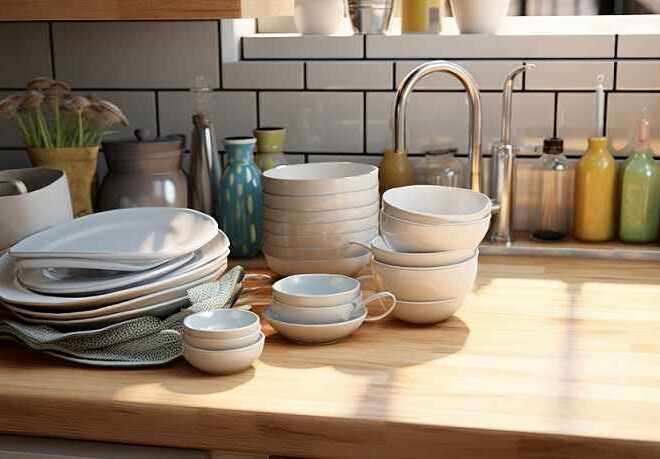
A Beginner’s Guide to Kitchen Tile Installation: Everything You Need to Know
Are you dreaming of transforming your kitchen into a stunning culinary oasis? One of the most impactful ways to elevate your space is by installing beautiful tile. Whether you’re aiming for sleek modernity, rustic charm, or vibrant patterns that pop, tile can redefine not just the aesthetics but also the functionality of your kitchen. But if you’re new to DIY projects, the thought of tackling tile installation might feel daunting. Fear not! In this beginner’s guide to kitchen tile installation, we’ll walk you through everything you need to know—from selecting the right tiles and tools to mastering essential techniques. Get ready to roll up your sleeves and unleash your inner designer as we simplify the process and empower you with all the tips and tricks for a successful tiling adventure!
Introduction: Why kitchen tile installation is important
Transforming your kitchen doesn’t just mean a new coat of paint or updated appliances. One of the most impactful changes you can make is through the installation of beautiful tiles. Kitchen tile installation not only enhances aesthetics but also improves functionality and durability. Whether you’re aiming for a sleek modern look or a rustic farmhouse vibe, choosing the right tiles can set the tone for your entire space.
Many homeowners may feel intimidated by this DIY project, but fear not! With some guidance and patience, anyone can master kitchen tile installation. In this beginner’s guide, we’ll walk you through everything from understanding different tile types to step-by-step instructions on how to install them like a pro. Let’s dive in and get started on transforming your kitchen into the heart of your home!
Understanding the different types of kitchen tiles
Choosing the right tile is essential for your kitchen. Each type has its unique features and benefits.
Ceramic tiles are popular due to their affordability and versatility. They come in a variety of colors and patterns, making it easy to find something that suits your style.
Porcelain tiles, on the other hand, offer greater durability. They are denser than ceramic and resist moisture better, which makes them ideal for high-traffic areas or homes with pets.
Natural stone tiles bring an organic touch to your space. Options like granite or travertine add elegance but require more maintenance due to their porous nature.
Understanding these types will help you make informed decisions when planning your kitchen tile installation. The choice ultimately depends on aesthetics, functionality, and personal preference.
-
Ceramic tiles
Ceramic tiles are a popular choice for kitchen flooring and backsplashes. They offer versatility in design, coming in various colors, patterns, and finishes. This makes it easy to match any kitchen theme or style.
One of the standout features of ceramic tiles is their durability. Resistant to moisture and stains, they make an excellent option for busy kitchens where spills are common. With proper care, these tiles can last for years without losing their charm.
Additionally, ceramic tiles are relatively affordable compared to other materials. Installing them can also enhance your home’s value—an appealing factor if you’re considering resale down the line.
Maintenance is straightforward too; regular sweeping and mopping keep them looking fresh. Their ability to withstand heavy foot traffic makes them a smart investment for any home chef eager to create their culinary haven.
-
Porcelain tiles
Porcelain tiles are a popular choice for kitchen installations due to their durability and low maintenance. Made from dense clay and fired at high temperatures, they offer remarkable strength and resistance to moisture.
One of the standout features of porcelain tiles is their versatility in design. Available in various colors, patterns, and textures, they can mimic natural stone or even wood while providing superior performance.
Another advantage is their stain resistance. Spills are less likely to penetrate the surface, making cleanup a breeze—perfect for busy kitchens where messes happen frequently.
Additionally, porcelain tiles have a timeless appeal that enhances any kitchen aesthetic. Whether you prefer a sleek modern look or something more rustic, there’s a porcelain option that fits your style perfectly.
With proper installation and care, these tiles can last for decades without losing their charm or functionality.
-
Natural stone tiles
Natural stone tiles bring a touch of elegance and sophistication to any kitchen. Each tile is unique, showcasing the beauty of nature with its distinct patterns and colors. From marble to granite, slate to travertine, there’s a wide variety available.
These tiles are incredibly durable, making them an excellent choice for high-traffic areas like kitchens. They can withstand heat and moisture better than many alternatives. However, proper sealing is essential to protect against stains.
Installation can be more complex compared to ceramic or porcelain tiles due to their weight and irregular shapes. It requires careful planning and precision to ensure they fit perfectly.
One remarkable feature of natural stone tiles is their ability to age gracefully. Over time, they develop character that adds charm and warmth. This makes them not just functional but also a long-term investment in your home’s aesthetic appeal.
Tools and materials needed for kitchen tile installation
When diving into kitchen tile installation, having the right tools and materials is essential for a smooth process. Start with a sturdy trowel. This tool will help spread adhesive evenly across your surface.
Next, don’t forget about spacers. These little gadgets ensure proper gaps between tiles for an even finish. Grout is another critical material; it fills those gaps and provides stability.
You’ll also need a level to check that everything is straight and aligned. A rubber mallet can gently tap tiles into place without damaging them.
A utility knife will come in handy for trimming tiles to fit snugly around edges or appliances. Lastly, safety gear like gloves and goggles keeps you protected throughout the project.
With these tools at your side, you’re well-equipped to tackle your kitchen tiling adventure!
-
Trowel, spacers, grout, etc.
When diving into kitchen tile installation, having the right tools makes all the difference. A notched trowel is essential for applying adhesive evenly. The size of the notch can affect how well tiles stick, so choose accordingly based on your tile’s thickness.
Tile spacers are another crucial tool. They help maintain consistent gaps between tiles, ensuring a professional finish. These tiny pieces might seem insignificant but play a vital role in achieving that clean look.
Grout is what fills those spaces once your tiles are set. It comes in various colors and types, allowing you to customize or contrast with your chosen tiles. Don’t forget to grab a grout float for easy application and smoothing!
Lastly, having a level on hand ensures everything stays straight while working through tricky areas like corners and edges. This simple step can save time and headaches down the road!
Preparing for installation
Before diving into kitchen tile installation, preparation is key. Start by measuring the area where you plan to lay tiles. Accurate measurements ensure that you purchase the right amount of materials and avoid waste.
Next, focus on cleaning the surface. Remove any dust, grease, or old adhesive residue. A clean workspace allows for better adhesion and a more professional finish.
Leveling the surface is equally important. If there are any dips or bumps, consider using a leveling compound to create an even base. This step will help prevent issues down the line with uneven tiles.
Taking these time-consuming yet vital steps can make your installation process smoother and more efficient than rushing through them at first glance
-
Measuring the space
Measuring your kitchen space accurately is a crucial first step in tile installation. Start by gathering your tools: a tape measure, pencil, and notepad.
Begin at one corner of the room and extend the tape to the opposite wall. Record both the length and width of the area you’ll be tiling. Be sure to note any obstacles like cabinets or appliances that may impact your layout.
Next, consider any unique features such as islands or nooks. Measure these separately to ensure every inch is accounted for. Take multiple measurements if needed; consistency matters.
Once you’ve gathered all dimensions, calculate square footage by multiplying length times width. This figure will guide you in purchasing tiles while minimizing waste—essential for staying within budget! Accurate measurements set a solid foundation for a seamless installation experience ahead.
-
Cleaning and leveling the surface
Before laying down your beautiful tiles, you need a clean and level surface. Start by thoroughly cleaning the area where you’ll be installing the tiles. Sweep away dust and debris, then mop to eliminate any grime or sticky residue.
Once it’s spotless, inspect for unevenness. Use a level tool to check that your floor is flat. If you find dips or bumps, consider using self-leveling compound to create an even base.
Allow this compound to dry completely before moving forward; rushing can lead to future complications with tile adhesion.
A well-prepared surface not only enhances the look of your finished product but also ensures durability over time. Taking these steps now will save headaches later on!
Step-by-step guide to installing kitchen tiles
Start by preparing your workspace. Lay down a drop cloth to protect surfaces and gather all your materials.
Next, apply the adhesive using a notched trowel. Spread it evenly across the surface where you’ll place the tiles. Aim for small sections at a time to prevent drying out.
Now it’s time for tile placement. Press each tile firmly into the adhesive, ensuring they’re aligned properly. Use spacers between tiles for uniform gaps.
Once all tiles are set, allow them to cure according to adhesive instructions before grouting. Mix your grout thoroughly until smooth.
Begin applying grout with a rubber float, filling in those gaps completely. Wipe off excess grout with a damp sponge while it’s still wet but take care not to remove too much from between the tiles.
After everything has dried, seal the grout lines if necessary to enhance durability and keep moisture out of those crucial kitchen areas.
-
Applying adhesive
Applying adhesive is a crucial step in the kitchen tile installation process. Start by choosing the right adhesive for your specific tile type. Not all adhesives are created equal, and selecting one that matches your tiles ensures better results.
Once you have your adhesive ready, use a notched trowel to spread it on the surface. Hold the trowel at an angle of about 45 degrees. This creates even ridges that help secure tiles firmly in place.
Work in small sections to maintain control over the application and prevent drying out before placing tiles. Make sure to press down firmly as you lay each tile, ensuring full contact with the adhesive beneath.
Don’t forget to clean up any excess adhesive immediately—this prevents unsightly messes once they dry! Keeping this area tidy will save time when grouting later on.
-
Placing and aligning tiles
Once you’ve applied the adhesive, it’s time to place your tiles. Start at a corner or a reference line for better alignment.
Gently press each tile into the adhesive, ensuring not to disturb the surrounding ones. A slight twist as you set them can help create an even bond with the mortar below.
Use spacers between tiles to maintain uniform gaps. These small pieces play a crucial role in achieving that professional look you desire.
As you work your way across the surface, keep checking for levelness and adjust as needed. If a tile feels higher than its neighbor, lift it and reapply pressure until it’s flush.
Don’t rush this step; patience pays off here! Consistent spacing and alignment will make grouting easier later on and enhance the overall appearance of your kitchen floor or backsplash.
-
Grouting and sealing
Grouting is a crucial step that fills the gaps between tiles, providing stability and preventing moisture from seeping beneath. Start by mixing your grout according to the manufacturer’s instructions. Aim for a smooth, creamy consistency that’s easy to spread.
Using a rubber float, apply the grout diagonally across the tiles. This ensures that it gets into every crevice while helping to remove excess from the surface. Wipe away any remaining grout with a damp sponge before it dries completely.
After allowing the grout to set for about 24 hours, sealing comes next. A good quality sealant protects against stains and keeps your kitchen looking fresh longer. Apply an even layer of sealant over the grouted areas using a paintbrush or applicator pad.
Let it dry as per product guidelines before you begin using your newly tiled space again. Proper grouting and sealing can enhance durability significantly.
Tips for a successful installation
When tackling kitchen tile installation, preparation is key. Before you start, gather all your materials and tools to avoid interruptions.
Pay attention to the layout. Dry fit tiles in place before adhering them. This helps visualize patterns and make necessary adjustments.
Be mindful of the adhesive application. Use an appropriate trowel size for even coverage. A thick layer can lead to slippage or uneven surfaces.
Corners and edges often present challenges. Cut tiles with precision to ensure a snug fit, minimizing visible gaps.
Don’t rush during grouting; let it set properly between applications. Wipe off excess grout promptly for a clean finish.
Lastly, patience pays off! Take breaks if needed—this isn’t just about speed but quality too. Enjoy every step of transforming your kitchen space into something beautiful!
-
Avoiding common mistakes
When it comes to kitchen tile installation, attention to detail is crucial. One common mistake is neglecting to measure accurately. Always double-check your measurements before cutting tiles. A small error can lead to larger issues down the line.
Another pitfall is skipping the surface preparation step. Make sure your floor is clean and level before you start laying tiles. Uneven surfaces can cause cracks and uneven wear.
Not using spacers consistently can result in uneven grout lines, which detracts from the overall look of your project. Spacers help maintain uniformity between tiles, so don’t overlook them.
Lastly, rushing through grouting may seem tempting but it’s a mistake that often leads to problems later on. Take your time with this step for a polished finish that lasts longer and looks great!
-
Dealing with tricky areas like corners and edges
Corners and edges can be the most challenging parts of kitchen tile installation. They require precision and a little creativity.
Start by measuring each section carefully. When cutting tiles to fit around corners, use a wet saw for clean edges. This tool helps you avoid chipping, ensuring a polished look.
Always dry-fit your tiles before applying adhesive. Lay them out in their intended positions to see how they align with other pieces. Adjust as needed for an even flow throughout the space.
When it comes to grouting, take your time in these tight areas. Use a smaller grout float or even your fingers for better control. Make sure not to overfill gaps; this could lead to uneven surfaces later on.
Patience is key here; rushing may result in unsightly finishes that you’ll regret down the line. Quality work will shine through in those detail-oriented spots!
Maintaining your kitchen tiles
Keeping your kitchen tiles in top shape doesn’t have to be a chore. Regular maintenance can extend their life and keep them looking new.
Start with simple cleaning methods. Use a damp mop or cloth for daily upkeep, avoiding harsh chemicals that can damage the surface. For deeper cleans, consider a mixture of warm water and mild soap.
Pay attention to grout lines too; they often collect dirt and grime. A soft brush can work wonders here, allowing you to reach those pesky spots without scratching the tile.
If spills occur, act fast! Wipe up any messes immediately to prevent staining or discoloration.
Lastly, don’t forget periodic sealing for natural stone tiles. This adds an extra layer of protection against moisture and stains while enhancing their beauty.
With these easy tips, your kitchen tiles will stay stunning for years to come.
-
Cleaning methods
Cleaning your kitchen tiles is essential for maintaining their appearance and longevity. Regular upkeep helps prevent grime buildup and keeps your space looking fresh.
For daily cleaning, a simple solution of warm water mixed with a few drops of mild dish soap works wonders. Use a soft mop or cloth to avoid scratching the surface. For tougher stains, you can create a paste using baking soda and water. Apply it to the stained area, let it sit for 10-15 minutes, then scrub gently with a non-abrasive sponge.
If you’re dealing with grout lines that have darkened over time, consider using a mixture of vinegar and water or specialized grout cleaners. Always remember to rinse thoroughly after cleaning any product off the tiles.
Sealing natural stone tiles every year will help protect them from stains and moisture damage. If you notice any dulling in shine or color on porcelain or ceramic tiles, polishing them occasionally can restore their luster.
By following these maintenance tips alongside proper installation practices detailed in this guide, you’ll ensure that your kitchen tile remains beautiful for years to come. Happy tiling!


